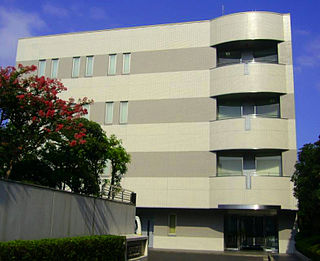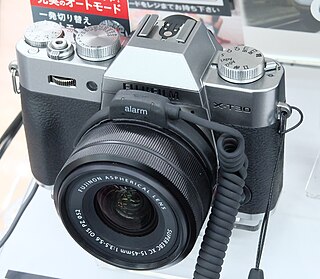
A charge-coupled device (CCD) is an integrated circuit containing an array of linked, or coupled, capacitors. Under the control of an external circuit, each capacitor can transfer its electric charge to a neighboring capacitor. CCD sensors are a major technology used in digital imaging.

The Nikon D1 is a digital single-lens reflex camera (DSLR) that was made by Nikon Corporation introduced on June 15, 1999. It features a 2.7-megapixel image sensor, 4.5-frames-per-second continuous shooting, and accepts the full range of Nikon F-mount lenses. The camera body strongly resembles the F5 and has the same general layout of controls, allowing users of Nikon film SLR cameras to quickly become proficient in using the camera. Autofocus speed on the D1 series bodies is extremely fast, even with "screw-driven" AF lenses.

High-speed photography is the science of taking pictures of very fast phenomena. In 1948, the Society of Motion Picture and Television Engineers (SMPTE) defined high-speed photography as any set of photographs captured by a camera capable of 69 frames per second or greater, and of at least three consecutive frames. High-speed photography can be considered to be the opposite of time-lapse photography.

Digital photography uses cameras containing arrays of electronic photodetectors interfaced to an analog-to-digital converter (ADC) to produce images focused by a lens, as opposed to an exposure on photographic film. The digitized image is stored as a computer file ready for further digital processing, viewing, electronic publishing, or digital printing. It is a form of digital imaging based on gathering visible light.

An image sensor or imager is a sensor that detects and conveys information used to form an image. It does so by converting the variable attenuation of light waves into signals, small bursts of current that convey the information. The waves can be light or other electromagnetic radiation. Image sensors are used in electronic imaging devices of both analog and digital types, which include digital cameras, camera modules, camera phones, optical mouse devices, medical imaging equipment, night vision equipment such as thermal imaging devices, radar, sonar, and others. As technology changes, electronic and digital imaging tends to replace chemical and analog imaging.

An active-pixel sensor (APS) is an image sensor, which was invented by Peter J.W. Noble in 1968, where each pixel sensor unit cell has a photodetector and one or more active transistors. In a metal–oxide–semiconductor (MOS) active-pixel sensor, MOS field-effect transistors (MOSFETs) are used as amplifiers. There are different types of APS, including the early NMOS APS and the now much more common complementary MOS (CMOS) APS, also known as the CMOS sensor. CMOS sensors are used in digital camera technologies such as cell phone cameras, web cameras, most modern digital pocket cameras, most digital single-lens reflex cameras (DSLRs), mirrorless interchangeable-lens cameras (MILCs), and lensless imaging for cells.

The Nikon D3 is a 12.0-megapixel professional-grade full frame (35 mm) digital single lens reflex camera (DSLR) announced by the Nikon Corporation on 23 August 2007 along with the Nikon D300 DX format camera. It was Nikon's first full-frame DSLR. The D3, along with the Nikon D3X, was a flagship model in Nikon's line of DSLRs, superseding the D2Hs and D2Xs. It was replaced by the D3S as Nikon's flagship DSLR. The D3, D3X, D3S, D4, D4s, D5, D6, D700, D800, D800Е and Df are the only Nikon FX format DSLRs manufactured in Japan. The D3S was replaced by the D4 in 2012.

Medipix is a family of photon counting and particle tracking pixel detectors developed by an international collaboration, hosted by CERN.

A back-illuminated sensor, also known as backside illumination (BI) sensor, is a type of digital image sensor that uses a novel arrangement of the imaging elements to increase the amount of light captured and thereby improve low-light performance.

The Nikon Expeed image/video processors are media processors for Nikon's digital cameras. They perform a large number of tasks: Bayer filtering, demosaicing, image sensor corrections/dark-frame subtraction, image noise reduction, image sharpening, image scaling, gamma correction, image enhancement/Active D-Lighting, colorspace conversion, chroma subsampling, framerate conversion, lens distortion/chromatic aberration correction, image compression/JPEG encoding, video compression, display/video interface driving, digital image editing, face detection, audio processing/compression/encoding and computer data storage/data transmission.

The Samsung Galaxy S series is a line of flagship Android smartphone and tablet computer produced by Samsung Electronics. In conjunction with the foldable Galaxy Z series, the lineup serves as Samsung's flagship smartphone lineup.

The Nikon D7100 is a 24.1-megapixel digital single-lens reflex camera model announced by Nikon in February 2013. It is a 'prosumer' model that replaces the Nikon D7000 as Nikon's flagship DX-format camera, fitting between the company's entry-level and professional DSLR models. This camera is the first ever from Nikon with no optical low-pass filter incorporated. At launch, Nikon gave the D7100 estimated selling price in the United States as US$ 949.95 for the body.

Photron is an international company that manufactures high-speed digital cameras based in Tokyo, Japan, with offices in San Diego, California and the United Kingdom.

The Photron FASTCAM Super 10K is a 512 x 480 High-speed camera. It is part of the Photron FASTCAM line of cameras, introduced in 1996. Photron FASTCAM Super 10k was introduce in 2000. However, the camera was trade branded previously in 1992 as a KODAK MASD product. The Kodak Motioncorder and the Photron FASTCAM Super 10K are the same camera, just different trade names.

The Photron FASTCAM Ultima 40K is a 256 x 256 High-speed camera. It is part of the Photron FASTCAM line of cameras, introduced in 1996. Photron FASTCAM Ultima 40K was introduce in 2000. However, the camera was trade branded previously in 1992 as a KODAK MASD product. The Kodak HS4540 and the Photron Ultima 40K are the same camera, just different trade names.

The Photron FASTCAM SPECTRA is a 256 x 256 High-speed camera coupled with an image intensifier. The image intensifier can shutter to 20 nanoseconds and has a spectral response between 180 nm to 800 nm. It is part of the Photron FASTCAM line of cameras, introduced in 1998.

The KODAK Motioncorder is a 512 x 480 High-speed camera. It is part of the Photron FASTCAM line of cameras, introduced in 1996. Photron Kodak Motioncorder was introduce in 1996. The camera was manufacture by Photron but trade branded as a KODAK MASD product. The Kodak Motioncorder and the Photron FASTCAM Super 10K Motioncorder are the same camera, just different trade names.

The Photron FASTCAM Ultima 512 is a 512 × 512 high-speed camera. It is part of the Photron FASTCAM line of cameras. The Photron FASTCAM Ultima 512 was introduced in 2001.

The Fujifilm X-T3 is a mirrorless interchangeable-lens digital camera announced on September 6, 2018. It is weather-resistant, has a backside-illuminated X-Trans CMOS 4 APS-C sensor and an X-Processor 4 quad core processor. It is the successor to 2016's Fujifilm X-T2. It uses the Fujifilm X-mount.

The Fujifilm X-T30 is a mirrorless interchangeable-lens camera announced by Fujifilm on February 14, 2019. The X-T30 is a successor to the X-T20, which was released in 2017. It is sold in three finishes: black, silver and charcoal silver.



















